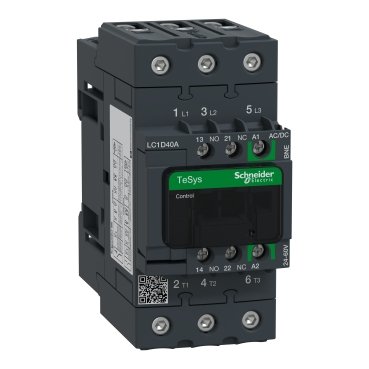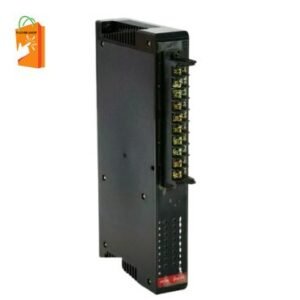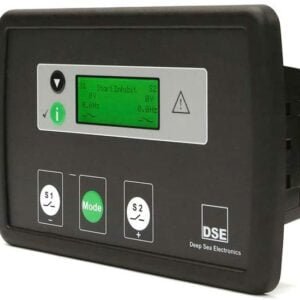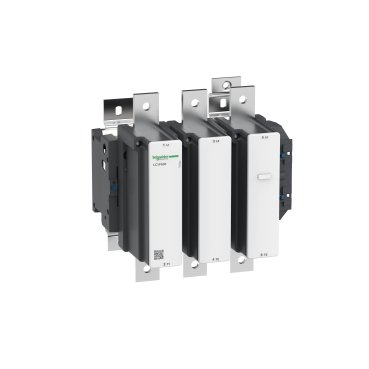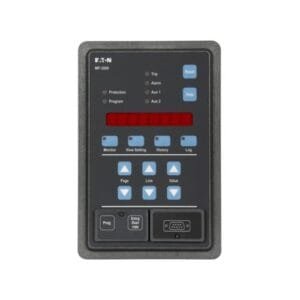LC1D40ABNE TeSys D contactor 3P 40A AC-3
Original price was: $97.00.$75.00Current price is: $75.00.
This 40A three-pole contactor from Schneider Electric is engineered for AC-3 duty, providing dependable performance for switching applications.
2 in stock
Free shipping on orders over $5000!
- Satisfaction Guaranteed
- No Hassle Refunds
- Secure Payments
Description
| range | TeSys. TeSys Deca. |
|---|---|
| range of product | TeSys D. TeSys Deca. |
| product or component type | Contactor. |
| device short name | LC1D. |
| contactor application | Resistive load. Motor control. |
| utilisation category | AC-3. AC-1. AC-3e. |
| poles description | 3P. |
| [Ue] rated operational voltage | Power circuit: <= 690 V AC 25…400 Hz. |
| [Ie] rated operational current | 60 A (at <60 °C) at <= 440 V AC-1 for power circuit.. 40 A (at <60 °C) at <= 440 V AC-3 for power circuit. 40 A (at <60 °C) at <= 440 V AC-3e for power. circuit. |
| [Uc] control circuit voltage | 24…60 V AC 50/60 Hz. 24…60 V DC. |
.
| motor power kW | 11 kW at 220…230 V AC 50 Hz (AC-3). 18.5 kW at 380…400 V AC 50 Hz (AC-3). 22 kW at 415 V AC 50 Hz (AC-3). 22 kW at 440 V AC 50 Hz (AC-3). 22 kW at 500 V AC 50 Hz (AC-3). 30 kW at 660…690 V AC 50 Hz (AC-3). 11 kW at 220–230 V AC, 50 Hz (AC-3e). 18.5 kW at 380…400 V AC 50 Hz (AC-3e). 22 kW at 415 V AC 50 Hz (AC-3e). 22 kW at 440 V AC 50 Hz (AC-3e). 22 kW at 500 V AC 50 Hz (AC-3e). 30 kW at 660…690 V AC 50 Hz (AC-3e). |
|---|---|
| motor power hp | 3 hp at 115 V AC 60 Hz for 1 phase motors. 5 hp at 230/240 V AC 60 Hz for 1 phase motors. 10 hp at 200/208 V AC 60 Hz for 3 phases motors. 10 hp at 230/240 V AC 60 Hz for 3-phase motors. 30 hp at 460/480 V AC 60 Hz for 3-phase motors. 30 hp at 575/600 V AC 60 Hz for 3-phase motors. |
| compatibility code | LC1D. |
| pole contact composition | 3 NO. |
| protective cover | With. |
| [Ith] conventional free air thermal current | 60 A (at 60 °C) for the power circuit. 10 A (at 60 °C) for the signaling circuit. |
| Irms rated making capacity | 800 A at 440 V for a power circuit conforming to IEC 60947. 140 A AC for signalling circuits conforming to IEC 60947-5-1. 250 A DC for the signaling circuit conforming to IEC 60947-5-1. |
| rated breaking capacity | 800 A at 440 V for a power circuit conforming to IEC 60947. |
| [Icw] rated short-time withstand current | 72 A, 40 °C, 10 min for the power circuit. 165 A, 40 °C, 1 min for the power circuit. 320 A, 40 °C, 10 s for the power circuit. 720 A, 40 °C, 1 s for the power circuit. 100 A – 1 s for the signaling circuit. 120 A to 500 ms for the signaling circuit. 140 A to 100 ms for the signaling circuit. |
| associated fuse rating | 80 A gG at <= 690 V coordination type 1 for the power circuit. 80 A gG at <= 690 V coordination type 2 for the power circuit. 10 A gG for the signaling circuit conforming to IEC 60947-5-1. |
| average impedance | 1.5 mOhm (60 A, 50 Hz) for a power circuit. |
| power dissipation per pole | 5.4 W AC-1. 2.4 W AC-3. 2.4 W AC-3e. |
| [Ui] rated insulation voltage | Power circuit: 690 V, conforming to IEC 60947-4-1. Signaling circuit: 690 V, conforming to IEC 60947-1. |
| overvoltage category | III. |
| pollution degree | 3. |
| [Uimp] rated impulse withstand voltage | 6 kV, conforming to IEC 60947. |
| safety reliability level | B10d = 1369863 cycles of contactor with a nominal load conforming to EN/ISO 13849-1. B10d = 20000000 cycles of contactor with mechanical load conforming to EN/ISO 13849-1. |
| mechanical durability | 6 Mcycles. |
| control circuit type | AC/DC at 50/60 Hz AC/DC electronic. |
| coil technology | Built-in bidirectional peak limiting. |
| control circuit voltage limits | <= 0.1 Uc (-40…70 °C): drop-out AC/DC. 0.85…1.1 Uc (-40…60 °C): operational AC. 0.8…1.1 Uc (-40…60 °C): operational DC. 1…1.1 Uc (60…70 °C): operational AC/DC. |
| operating time | 55–65 ms. closing. 20…120 ms opening (date code >= 17221). 20…80 ms opening (date code >= 18011). |
| maximum operating rate | 3600 cyc/h, 60 °C. |
| tightening torque | Control circuit: 1.7 N.m. on screw clamp terminals with a screwdriver flat Ø 6 mm. Control circuit: 1.7 N.m. on screw clamp terminals with screwdriver Philips No. 2. Power circuit: 8 N.m. on EverLink BTR screw. connectors; cable 25 35 mm² hexagonal screw head, 4 mm. Power circuit: 5 N.m. on EverLink BTR screw connectors, cable 1 25 mm² hexagonal screw head, 4 mm. Power circuit: 2.5 N.m. on lug-ring terminals, with screwdriver pozidriv No. 2 M4. Control circuit: 1.7 N.m. on lugs-ring terminals, with screwdriver pozidriv No. 2 M3.5. |
| auxiliary contact composition | 1 NO + 1 NC. |
| auxiliary contacts type | Type mechanically linked: 1 NO + 1 NC, conforming to IEC 60947-5-1. type mirror contact 1 NC, conforming to IEC 60947-4-1. |
| signalling circuit frequency | 25…400 Hz. |
| minimum switching voltage | 17 V for the signaling circuit. |
| minimum switching current | 5 mA for the signaling circuit. |
| insulation resistance | > 10 MOhm for the signaling circuit. |
| non-overlap time | 1.5 ms on de-energization between NC and NO contact. 1.5 ms on energization between NC and NO contact. |
| mounting support | Plate. Rail. |
| IP degree of protection | IP20 front face conforms to IEC 60529. |
|---|---|
| climatic withstand | Conforming to IACS E10. conforming to IEC 60947-1 Annex Q category D. |
| operating altitude | 0…3000 m. |
| fire resistance | 850 °C, conforming to IEC 60695-2-1. |
| flame retardance | V1 conforms to UL 94. |
| height | 122 mm. |
| width | 55 mm. |
| depth | 120 mm. |
| net weight | 0.992 kg. |
| Unit Type of Package 1 | PCE |
|---|---|
| Number of Units in Package 1 | 1 |
| Package 1 Height | 6.2 cm. |
| Package 1 Width | 13.7 cm. |
| Package 1 Length | 15.2 cm. |
| Package 1 Weight | 1.05 kg. |
| Unit Type of Package 2 | S02. |
| Number of Units in Package 2 | 9 |
| Package 2 Height | 15 cm. |
| Package 2 Width | 30 cm. |
| Package 2 Length | 40 cm. |
| Package 2 Weight | 9.75 kg. |

